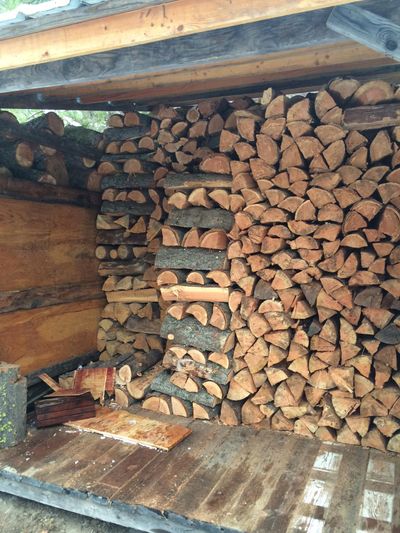Off the grid: Helpful tips for cutting, seasoning and storing firewood

Part of a semi-regular series of yarns about living off the grid, even if for a weekend.
Never one to scoff at free wood, the recent wind storms created a bonanza for a certain cabin-owning weekend warrior who believes, much like money, that there is no such thing as too much firewood.
As I stashed three truck loads into a dark corner to season for a year, I have come to a very disturbing truth: Most folks don’t have the first clue how to properly cut and process firewood.
A case in point is a co-worker who had a goodly pile of rounds cut by a paid arborist, who was hired by an insurance company to remove the neighbor’s white firs which unceremoniously smashed into the co-worker’s roof.
I agreed to bring my truck, “Elk Commander,” over to remove said rounds. I was happy to add to my house’s wood supply and help a co-worker clean up his yard after the disastrous storm.
But as I arrived, my disappointment began. Every round was a different length. Some were less than 9 inches long and others up to 30. Whoever cut that wood doesn’t have any experience trying to manage a large supply.
My father used to say he’d like to break the hands of the man who built our former house, so the builder couldn’t repeat his mistakes. I felt the same way about the man or woman who cut my co-worker’s trees.
But it occurred to me that so few people actually use wood to heat their cabins or homes anymore that it’s time to talk about proper firewood etiquette.
POPULAR BOY
My popularity in the neighborhood tends to rise or fall depending on when I choose to bring home a load of firewood. Unloading is a loud business, with wood banging around the back of my pickup until well after dark. The noise train continues until all the chunks are properly stacked on the side of the house.
But after the hurricane-force winds hit Spokane in November, I became an overnight sensation. Folks who had fireplaces that did nothing for years but decorate their front rooms all of the sudden needed fuel to heat their powerless homes.
Something that I do out of joy, all of the sudden became a hot commodity.
But I’m also proud of my work. My wife laments every time I post a picture on a certain social media site about a recently stacked cord. “Tom really likes to show off his wood,” she says.
Even my father, the one who seeks to break hands, often asks me why I cut every piece of firewood exactly the same length. The answer is simple: Because I care.
I’ve seen videos of guys who will take long tape measures and meticulously measure and mark each round before cutting. I have no problem with this method, but I learned a simpler, quicker, way.
I cut my wood for the house and the wood stove for my wall tent all at 18 inches. I know my friends, Timmy and Iceman, have fireplace inserts that require pieces at 16 inches or less. And, my wood stove in the cabin is tiny so it can only burn rounds up to 9 inches long.
Knowing this, I took a Sharpie pen and marked 18, 16 and 9 inches on my chainsaw bar. All I do is turn my chainsaw, measure the mark and cut. It’s quick, its easy and all the pieces generally come out the same length.
STACKING FOR SUCCESS
Cutting wood the same length really comes into play when stacking and storing the wood to dry, or season.
Most folks don’t have a ready-made wood rack to store cut wood. I learned a very handy way around that problem.
When you cut and split your wood, simply alternate each course of wood when you stack on either end. This creates a virtual wall on both sides that allows you to stack the middle pieces without the fear of the wood falling down. It also allows you to get more wood in your stack.
I also highly suggest building either a seasoning shed or a covered wood rack on the side of your home under the eaves. Unless it’s standing buckskin, meaning that the tree was dead and so dry the bark was falling off, most wood requires a minimum of a year of seasoning to burn correctly.
The vast majority of the wood that came down in Spokane and North Idaho during the wind storm was green Ponderosa pine. “Green” just means that the tree was alive when it crashed and took out the power grid. That green wood needs about a year of drying to just to make it easier to split.
But the good news is that pine creates a very hot, if not very long-lasting, fire for those who seek to keep their fireplaces more than just decorations.
SEASON FOR ALL SEASONS
Managing a stack of wood doesn’t sound all that complicated, and it isn’t.
But, you need to remember to stack the wood in such a way to get to the oldest, therefore, driest wood first.
I built a simple 8x8-foot structure with a roof that hangs over 2 feet on both sides. This allows me to stack the good stuff inside and leaves me room to put unsplit rounds on the outside, yet remain under roof.
While December is the prime wood-burning time, this also becomes the time of year when I begin to gather all the wood I will burn in the fall of 2016.
The cold temperatures provide the perfect time for the labor-intensive work while giving the wood plenty of time under roof during the summer to dry enough for future burning seasons.